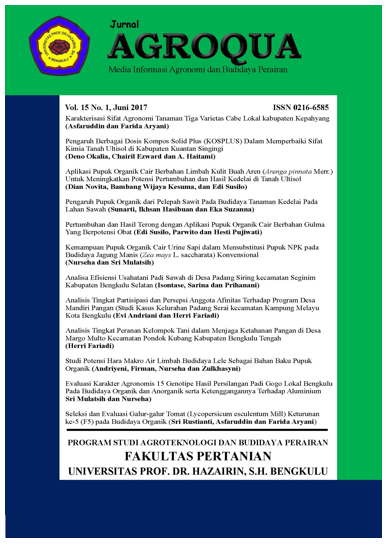DAMPAK CEKAMAN MUKA AIR TANAH TERHADAP MORFOLOGIS, ANATOMIS DAN FISIOLOGIS TANAMAN BUNCIS (Phaseolus vulgaris L.) DI FASE GENERATIF
DOI:
https://doi.org/10.32663/ja.v20i2.3248Keywords:
adaptation, beans, hypoxia, riparian wetlandsAbstract
Land conversion activities have reduced the availability of dry land for vegetable cultivation, therefore optimization of wetlands needs to be done. One of the potential wetlands is riparian wetlands. This study aims to determine the morphological, anatomical and physiological effects of shallow water table stress and waterloging on beans in riparian wetlands. The research was conducted from October 2017 to January 2018 in experimental ponds located in the Demang Lebar Daun Village, Palembang and at the Postgraduate Integrated Laboratory, Faculty of Agriculture, Sriwijaya University, Palembang. The study used a randomized block design (RBD) with control treatment (not soaked), M-13 (Water table at 13 cm below the soil surface), M-8 (Water table at8 cm below the soil surface), M-3 (Water table at 3 cm below the soil surface) and WL+2 (waterloging at 2 cm above ground level). Each treatment was repeated 3 times. The results showed that water table at 3 cm below the soil surface and waterloging increased proline content but decreased chlorophyll content, relative leaf expansion rate (RLER), specific leaf fresh weight (SLFW), and specific leaf water content (SLWC). Root tissue was formed one day after the treatment. Beans treatedwith water table at 3 cm below the soil surface and waterlogingwere only able to survive for 6 days. Beans are the adaptive plant to water table of more than 3 cm under the soil surface and has prospects for development in riparian wetland.
References
Downloads
Published
Issue
Section
License
Authors who publish with this journal agree to the following terms:
- Authors grant the journal right of first publication with the work simultaneously licensed under a Creative Commons Attribution 4.0 Internasional (CC BY 4.0) Licence that allows others to use and share the work with an acknowledgment of the work's authorship and initial publication in this journal.
- The author(s) still hold the copyright of his/her/their work and retain publishing rights without restrictions such as (but not limited to) patent right, lecture, book and reproduce the article for own purposes.
















